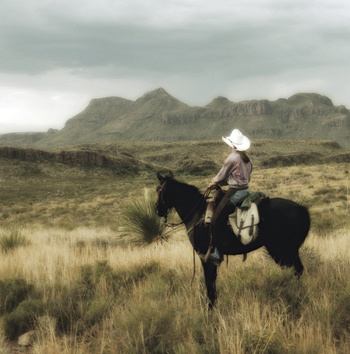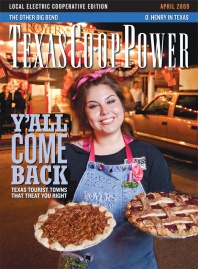I am doing the shake and bake to the Left Hand Shutup, and though that sounds like some sort of newfangled dance, the desert view through the windshield tells a different story.
I am riding shotgun with Big Bend Ranch State Park ranger Bill Broyles. The 14-year veteran of the Texas Parks and Wildlife Department (TPWD) steers his Suburban deftly over the bumpy roads. We are heading toward the Solitario—Spanish for lonely or solitary—a collapsed volcano that forms the park’s signature geological feature. The Left Hand Shutup is one of three steep canyons that drain this caldera, which in aerial photos looks like a giant carbuncle burst open on the earth’s cheek. As the sun warms the inside of our vehicle, the rough landscape outside looks as tan and wrinkled as the face of an old vaquero, while spiny ocotillo and stumpy yucca litter the mesas. Hidden seeps provide water for cottonwoods and wildlife.
“This country, you either love it or you hate it,” Broyles says of this far-flung, north-central portion of the Chihuahuan Desert. “It can be a little humbling, if you know what I’m saying.”
I know what Broyles is saying. I’ve come to this park to sample some new developments, including more than 50 new primitive campsites and an expanded trail system that will eventually offer more than 200 miles of multiple-use trails for hiking, biking and horseback riding. These latest efforts are part of the state of Texas’ push to encourage public use of the 300,000 acres of state land that extends along the Rio Grande from southeast of Presidio to near Lajitas. While it’s an area big and roaming in its own right—for example, it’s more than twice the size of Saguaro National Park in Arizona—the park is often overlooked by outdoor lovers who tend to stick with the 800,000-acre Big Bend National Park next door, to the east. Taken together, the two parks are an adventure wonderland, offering everything from overnight trips to the sky islands of the Chisos Mountains of the national park to day hikes to explore the hidden, bowl-like Cinco Tinajas (the Spanish name means five pools)—a narrow canyon in which five pools of water stairstep down the rock—in the heart of the state park that holds water year-round, attracting birds and other wildlife.
But even though the parks share many attributes—abundant bird life, expansive stretches of uninhabited scenery, acreage along the last wild stretches of the Rio Grande—they are as distinct in their character as the gregarious blue jay is to the demure bluebird. Both are beautiful, but whereas the national park is bold and in your face, the state park is shy, subtle and a little more difficult to know.
For while the Chisos Mountains in the national park climb high above the desert floor, offering a woodland respite from the rough and prickly ecology below, on the state land, it’s canyons and depressions like the caldera of the Solitario, which spans nine miles, that make the state park a special place for visitors. Considering that Big Bend Ranch is Texas’ largest state park, it’s all the more remarkable that while the neighboring national park gets nearly half a million visitors each year, a mere fraction of that—some 10,000 individuals—visit the state property. The rewards, however, include the chance to see ancient tribal pictographs created thousands of years ago, three of the four highest waterfalls in Texas and virtually limitless exploring by foot, horseback, mountain bike or four-wheel-drive vehicle.
Standing on the rim of the Solitario, before making our descent to the Shutup, a closed canyon where ranchers used to pen cattle, Broyles points out lonely beige peaks, such as Needle Peak at 4,608 feet, Solitario Peak at 4,786 feet and Fresno Peak at 5,131 feet, which marks the entrance to Fresno Canyon and appears as a needle-eye notch in the distance. At the base of that canyon, TPWD has worked with the Nature Conservancy to obtain the 7,000-acre Fresno Ranch, which is being assessed for public recreational use. Directly before us, we spy surreal geological patterns where hardened magma has congealed below limestone layers, created when the pre-Paleozoic sea covered the desert floor.
Elsewhere hoodoo spires—tall, skinny spires of rock that protrude from the bottom of arid basins and badlands—that rival those in Utah aim skyward, and breathtaking cliffs shine like quicksilver. It’s wilderness as far as I can see, reminding me of another name oldtimers had for the Big Bend: El Despoblado, Spanish for “the uninhabited land.”
Historically, extreme weather, lack of potable water in the park despite numerous springs (potable water is available at park headquarters) and rough roads have challenged all but the hardiest visitors to Big Bend Ranch State Park. Today, you will find a warm welcome at the Sauceda Complex, where visitors can sleep dormitory-style in the Sauceda Lodge Bunkhouse or take advantage of more expansive accommodations in the Big House. Sauceda, in the park interior, a 45-minute drive over rough ranch roads (though two-wheel drive is adequate), also offers a gift shop, mountain bike rentals (though, frankly, you are better off bringing your own), and an information center. On the park’s eastern edge near Lajitas, the recently renovated Barton Warnock Environmental Education Center has a 2-acre botanical garden highlighting desert species and can provide permits for backcountry camping and access to the Contrabando Loop, which offers the best biking in the park.
Deep down in the Solitario, the road reaches its end, and we leave the Suburban to stretch our legs and explore the Shutup. Birds flit along a brushy wash that looks like it hasn’t seen water in eons. Whether sparrows or flycatchers, neither Broyles nor I have the wherewithal to name our fast-moving feathered friends. Then the need for naming things passes in the canyon breeze, and I find that being in the depths of Big Bend Ranch brings with it a moment of serenity. There are few places left on the planet, much less in Texas, where the weight of the world can be sloughed off so completely. Even if you never intend to visit, this treasure that belongs to us seems worth celebrating.
——————–
Dan Oko, who lives in Austin, writes about the outdoors.


